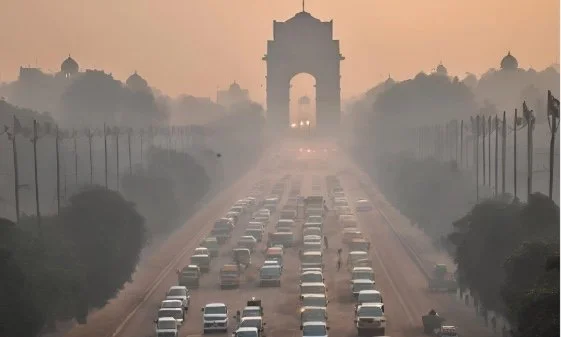India Accounts for 70% of Global Air Pollution Deaths: Report
Lancet Countdown Links PM2.5 to 1.72 Million Deaths in India Each Year
October 30, 2025
India accounts for nearly 70% of all global deaths caused by air pollution, according to a new international report by a global research collaboration, the Lancet Countdown. The report estimates that PM2.5 pollution in India is now responsible for around 1.72 million deaths each year, marking a sharp 38% rise since 2010.
To put that in perspective, the global annual death toll from air pollution is 2.5 million, notes the India CSR website, citing from the report, which was prepared by researchers at University College London in partnership with the World Health Organization. This means nearly three out of every four such deaths occur in India alone.
PM2.5 refers to extremely small particles in the air produced by human activities such as burning coal, petrol and biomass. These particles are so tiny that they can travel deep into the lungs and even enter the bloodstream, damaging organs and shortening lives.
The most deadly source is fossil fuel burning, says the report, which tracked the relationship between health and climate change worldwide.
Coal leads to an estimated 394,000 deaths annually in India, largely due to the harmful pollutants released when it is burned. Power plants are the main source of this damage, responsible for about 298,000 of those deaths. This happens because coal combustion produces high levels of PM2.5 along with sulphur dioxide, nitrogen oxides and heavy metals. These pollutants linger in the air, especially near coal-based thermal power plants, and over time, exposure leads to respiratory diseases, heart conditions, strokes and other serious health problems. The concentration of emissions near densely populated areas further increases health risks.
Petrol-powered vehicles contribute another 269,000 deaths. Taken together, fossil fuels are tied to 752,000 deaths a year in India, nearly half of the national total from air pollution.
Smoke from wildfires, which is increasing due to hotter, drier weather, has also become a bigger problem. From 2020 to 2024, wildfire smoke has caused an average of 10,200 deaths a year in India, up by 28% from what it was in the early 2000s.
The report also looked at pollution generated within Indian households. In many rural areas and poorer households, people still rely on wood, coal, or other dirty fuels for cooking and heating. This indoor air pollution adds to the health toll. In 2022, the death rate from household air pollution was 113 per 100,000 people on average. Rural areas were worse off, with 125 deaths per 100,000, compared to 99 in urban places.
The economic damage, according to the report, is just as staggering.
In 2022, early deaths caused by outdoor air pollution cost India $339.4 billion in lost income, which amounts to nearly 10% of the country’s GDP. The cost is calculated by estimating the income that would have been earned if those who died early due to outdoor air pollution had lived out their expected working years. This includes the value of lost wages, reduced productivity and the economic contributions those individuals would have made.
The report also draws attention to the effects of extreme heat, which is intensifying due to climate change.
In 2024, India saw 50% more days of dangerous heatwaves than usual. People were exposed to 366 extra hours of heat strong enough to cause serious stress. Workers lost about 419 hours of labour each year due to heat in 2024, which was 124% more than in the 1990s. That could translate to about $194 billion in lost wages in just one year.
There’s also a growing crisis in water security and disease.
Between 1951 and 1960, only 14% of India’s land faced at least one month of severe drought every year. Now, that has shot up by 138%. Drier conditions make life harder for farmers, affect food supply and put drinking water at risk. On top of this, hotter and wetter conditions are helping spread diseases.
Dengue, spread by Aedes albopictus mosquitoes, is now spreading faster and farther than before. Over the past 70 years, its basic transmission rate has doubled. Coastal regions are also seeing more infections caused by Vibrio bacteria, with current rates now 46% higher than they were from 1982 to 2010.
The message from the report is that climate change and pollution are killing people in India today, which is also costing billions of dollars and pushing health systems beyond their limits.
To prevent further human and economic loss, India must shift to cleaner energy sources for households, invest in sustainable public transport, and strengthen local systems for climate resilience, including early warning networks, heat action plans and drought preparedness.
You have just read a News Briefing by Newsreel Asia, written to cut through the noise and present a single story for the day that matters to you. Certain briefings, based on media reports, seek to keep readers informed about events across India, others offer a perspective rooted in humanitarian concerns and some provide our own exclusive reporting. We encourage you to read the News Briefing each day. Our objective is to help you become not just an informed citizen, but an engaged and responsible one.

